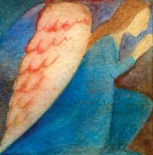
When we began rehearsing Francis Poulenc’s Quatre Motets pour le temps de Nöel (Four Motets for the time of Christmas), I noticed something curious in the score. At the end of each piece, the publishers listed date and location of the conclusion of its composition. There surely is a doctoral dissertation lurking in that detail (“Poulenc’s Christmas Bouillabaisse: Ontology and Place in the Composition of the Quatre Motets,” perhaps?). I found it interesting from a francophile’s perspective: I wonder if and how those places shaped Poulenc’s composition (destinations such as Noizay on the Loire, Marseille, Aix en Provence, and Paris surely appeal!). Alas, I shall have to leave such investigations to others.
The set of unaccompanied pieces begins with the text, O Magnum Mysterium, which ponders a paradox also considered by Bach in Cantata No. 40, the birth of an infant savior into conditions that don’t seem to befit his majesty. The text of the Poulenc marvels at Christ’s incarnation among the animals of the stable. Poulenc evokes this magnum mystery with splendidly mysterious music in the key of Bb-minor. In this compact masterpiece, one hears, almost at once, the enormous range of influences on Poulenc’s compositional style: from American Jazz, to the music of his impressionist forbearers; from the more conservative craftsmanship of Gabriel Fauré, to his contemporaries in the informal group of French composers to which Poulenc belonged (including Darius Milhaud and Arthur Honegger).
That craftsmanship is in evidence in the second motet, whose text begins with a question: Quem vidistis, pastores, dicite, annunciate nobis, in terris quis apparuit? (“Whom did you see, shepherds, tell us, announce to us, who appeared on earth?”). Poulenc evokes this question with unsettled music, the melodies always rising to the question mark, some voice parts singing the melody, accompanied by other singers moving in parallel motion with their mouths closed. Poulenc moves the singers through several moods, textures, and key signatures, demonstrating that particular French affinity for harmony and seamless modulations.
The next motet captures the journey of the Magi as they followed the star to Bethlehem, and includes some of the most challenging harmonies of this set of pieces. Poulenc combines a remarkably worshipful mood with some of the most overtly jazzy harmonies in the Four Motets, to great effect. The dissonances are exquisite, and somehow capture the bitterness of the myrrh, the bracing lift of the frankincense, and the shimmer of the gold.
Completing the set is the jubilant Hodie Christus Natus Est (“Today is born Christ the Savior”). Here, we find Poulenc capturing the glorias of the archangels and this piece sounds almost madrigalesque in its intimacy, but with especially jazzy harmonies. It also moves quite quickly, and a lot of care went into stacking and tuning chords that listeners will only hear for a second or two. This is rapturous music that crackles with joy and light.
The Motets are quite challenging for singers, both in the rhythmic and melodic demands, as well as the nettlesome yet brilliant harmony that is one of Poulenc’s trademarks. I’ve greatly enjoyed the process of learning them, and I think our audience will very much enjoy our efforts to master this music. These four pieces seem to live quite cheerfully among the other repertoire in this program, despite residing much closer to our present time, in terms of their harmony and melodies. With the first Bach piece on the program, we will hear the horns of battle and a stoic Lutheran confidence in God’s grace. With the Charpentier, we listen to a bevy of influences and source material in the hands of a master adapter, who creates a compelling sound picture of Christmas Eve. With the Poulenc, the composer uses a large palette of melody and harmony to paint the mysteries and joys of Christmastide. I will write next about our return to Bach’s music to conclude the concert, with Bach’s masterful evocation of the adoration of the shepherds.










































